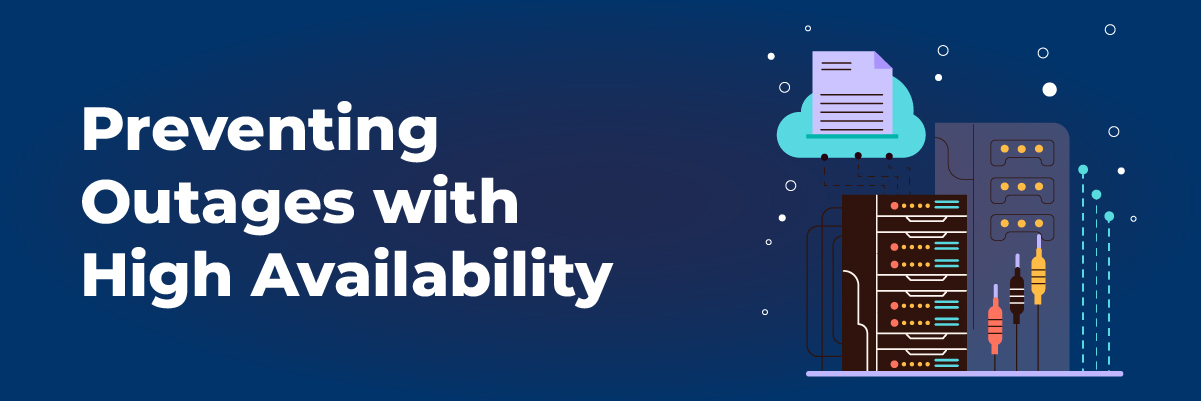
High Availability (HA) is a fundamental part of data management, ensuring that critical data remains accessible and operational despite unforeseen challenges. It’s a comprehensive approach that employs various strategies and technologies to prevent outages, minimize downtime, and maintain continuous data accessibility. The following are five areas that comprise a powerful HA deployment.
Redundancy and Replication: Redundancy and replication involve maintaining multiple copies of data across geographically distributed locations or redundant hardware components. For instance, in a private cloud environment, data may be replicated across multiple availability data centers. This redundancy ensures that if one copy of the data becomes unavailable due to hardware failures, natural disasters, or other issues, another copy can seamlessly take its place, preventing downtime and ensuring data availability. For example: On Premise Vs private cloud (AWS) offers services like Amazon S3 (Simple Storage Service) and Amazon RDS (Relational Database Service) that automatically replicate data across multiple availability zones within a region, providing high availability and durability.
Fault Tolerance: Fault tolerance is the ability of a system to continue operating and serving data even in the presence of hardware failures, software errors, or network issues. One common example of fault tolerance is automatic failover in database systems. For instance, in a master-slave database replication setup, if the master node fails, operations are automatically redirected to one of the slave nodes, ensuring uninterrupted access to data. This ensures that critical services remain available even in the event of hardware failures or other disruptions.
Automated Monitoring and Alerting: Automated monitoring and alerting systems continuously monitor the health and performance of data storage systems, databases, and other critical components. These systems use metrics such as CPU utilization, disk space, and network latency to detect anomalies or potential issues. For example, monitoring tools like PRTG and Grafana can be configured to track key performance indicators (KPIs) and send alerts via email, SMS, or other channels when thresholds are exceeded or abnormalities are detected. This proactive approach allows IT staff to identify and address potential issues before they escalate into outages, minimizing downtime and ensuring data availability.
For example, we write custom monitoring scripts, for our clients, that alert us to database processing pressure and long-running queries and errors. Good monitoring is critical for production database performance and end-user usability.
 Load Balancing: Load balancing distributes incoming requests for data across multiple servers or nodes to ensure optimal performance and availability. For example, a web application deployed across multiple servers may use a load balancer to distribute incoming traffic among the servers evenly. If one server becomes overloaded or unavailable, the load balancer redirects traffic to the remaining servers, ensuring that the application remains accessible and responsive. Load balancing is crucial in preventing overload situations that could lead to downtime or degraded performance.
Load Balancing: Load balancing distributes incoming requests for data across multiple servers or nodes to ensure optimal performance and availability. For example, a web application deployed across multiple servers may use a load balancer to distribute incoming traffic among the servers evenly. If one server becomes overloaded or unavailable, the load balancer redirects traffic to the remaining servers, ensuring that the application remains accessible and responsive. Load balancing is crucial in preventing overload situations that could lead to downtime or degraded performance.
Data Backup and Recovery: Data backup and recovery mechanisms protect against data loss caused by accidental deletion, corruption, or other unforeseen events. Regular backups are taken of critical data and stored securely, allowing organizations to restore data quickly in the event of a failure or data loss incident.
Continuous Software Updates and Patching: Keeping software systems up to date with the latest security patches and updates is essential for maintaining Data High Availability. For example, database vendors regularly release patches to address security vulnerabilities and software bugs. Automated patch management systems can streamline the process of applying updates across distributed systems, ensuring that critical security patches are applied promptly. By keeping software systems up-to-date, organizations can mitigate the risk of security breaches and ensure the stability and reliability of their data infrastructure.
Disaster Recovery Planning: Disaster recovery planning involves developing comprehensive plans and procedures for recovering data and IT systems in the event of a catastrophic failure or natural disaster. For example, organizations may implement multi-site disaster recovery strategies, where critical data and applications are replicated across geographically dispersed data centers. These plans typically outline roles and responsibilities, communication protocols, backup and recovery procedures, and alternative infrastructure arrangements to minimize downtime and data loss in emergencies.
We develop database disaster automatic failure procedures and processes for clients and work with programmers or IT departments to help them understand the importance of HA and how to change their code to optimize their use of High Availability.
An Essential Tool
Data High Availability is essential for preventing outages and ensuring continuous data accessibility in modern IT environments. By employing the strategies we outlined, you can mitigate the risk of downtime, maintain business continuity, and ensure the availability and reliability of critical data and services.
High Availability is available on all modern database platforms and requires a thoughtful approach. We’d be happy to show you how we can help your organization and make your applications and systems fly without disruption. Call us today.





